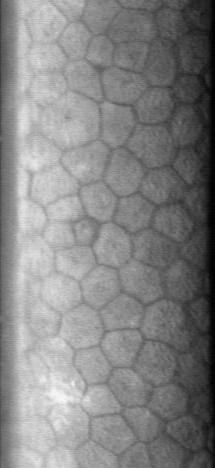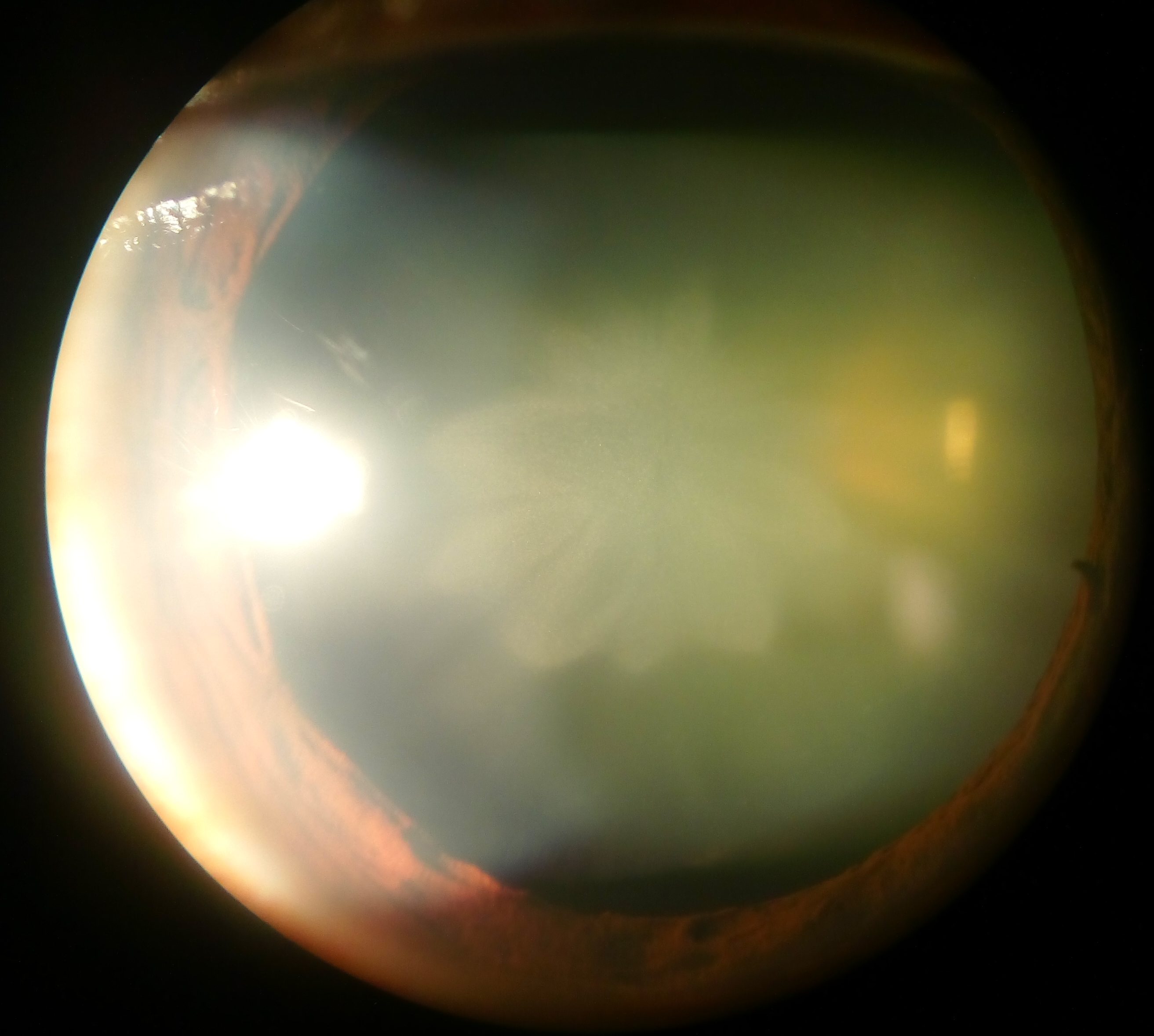|
Phakic Intraocular Lens
A phakic intraocular lens (PIOL) is an intraocular lens that is implanted surgically into the eye to correct refractive errors without removing the natural lens (also known as "phakos", hence the term). Intraocular lenses that are implanted into eyes after the eye's natural lens has been removed during cataract surgery are known as pseudophakic. Phakic intraocular lenses are indicated for patients with high refractive errors when the usual laser options for surgical correction (LASIK and PRK) are contraindicated. Phakic IOLs are designed to correct high myopia ranging from −5 to −20 D if the patient has enough anterior chamber depth (ACD) of at least 3 mm. Three types of phakic IOLs are available: * Angle-supported * Iris-fixated * Sulcus-supported intraocular lens Medical uses LASIK can correct myopia up to -12 to -14 D. The higher the intended correction the thinner and flatter the cornea will be post-operatively. For LASIK surgery, one has to preserve a safe ... [...More Info...] [...Related Items...] OR: [Wikipedia] [Google] [Baidu] |
Intraocular Lens
An intraocular lens (IOL) is a lens (optics), lens implanted in the human eye, eye usually as part of a treatment for cataracts or for correcting other vision problems such as myopia, near-sightedness (myopia) and farsightedness, far-sightedness (hyperopia); a form of refractive surgery. If the natural lens is left in the eye, the IOL is known as Phakic intraocular lens, ''phakic'', otherwise it is a ''pseudophakic'' lens (or false lens). Both kinds of IOLs are designed to provide the same light-focusing function as the natural crystalline lens. This can be an alternative to LASIK, but LASIK is not an alternative to an IOL for treatment of cataracts. IOLs usually consist of a small plastic lens with plastic side struts, called haptics, to hold the lens in place in the capsular bag inside the eye. IOLs were originally made of a rigid material (Poly(methyl methacrylate), PMMA), although this has largely been superseded by the use of flexible materials, such as silicone. Most IOLs ... [...More Info...] [...Related Items...] OR: [Wikipedia] [Google] [Baidu] |
Myopia
Myopia, also known as near-sightedness and short-sightedness, is an eye condition where light from distant objects focuses in front of, instead of on, the retina. As a result, distant objects appear blurry, while close objects appear normal. Other symptoms may include headaches and eye strain. Severe myopia is associated with an increased risk of macular degeneration, retinal detachment, cataracts, and glaucoma. Myopia results from the length of the eyeball growing too long or less commonly the lens being too strong. It is a type of refractive error. Diagnosis is by the use of cycloplegics during eye examination. Tentative evidence indicates that the risk of myopia can be decreased by having young children spend more time outside. This decrease in risk may be related to natural light exposure. Myopia can be corrected with eyeglasses, contact lenses, or by refractive surgery. Eyeglasses are the simplest and safest method of correction. Contact lenses can provide a rela ... [...More Info...] [...Related Items...] OR: [Wikipedia] [Google] [Baidu] |
Iridectomy
An iridectomy, also known as a surgical iridectomy or corectomy, is the surgical removal of part of the iris.Cline D; Hofstetter HW; Griffin JR. ''Dictionary of Visual Science''. 4th ed. Butterworth-Heinemann, Boston 1997. Surgery Encyclopedia - "Iridectomy." Encyclopedia of Surgery: A Guide for Patients and Caregivers. Retrieved May 20, 2006. These procedures are most frequently performed in the treatment of closed-angle glaucoma and iris . Comparison with Nd:YAG laser iridotomy In[...More Info...] [...Related Items...] OR: [Wikipedia] [Google] [Baidu] |
Miosis
Miosis, or myosis (), is excessive constriction of the pupil. citing: Mosby's Medical Dictionary, 8th ed. The opposite condition, mydriasis, is the dilation of the pupil. Anisocoria is the condition of one pupil being more dilated than the other. Causes Age * Senile miosis (a reduction in the size of a person's pupil in old age)Diseases *[...More Info...] [...Related Items...] OR: [Wikipedia] [Google] [Baidu] |
Corneal Endothelium
The corneal endothelium is a single layer of endothelial cells on the inner surface of the cornea. It faces the chamber formed between the cornea and the iris. The corneal endothelium are specialized, flattened, mitochondria-rich cells that line the posterior surface of the cornea and face the anterior chamber of the eye. The corneal endothelium governs fluid and solute transport across the posterior surface of the cornea and maintains the cornea in the slightly dehydrated state that is required for optical transparency. Embryology and anatomy The corneal endothelium is embryologically derived from the neural crest. The postnatal total endothelial cellularity of the cornea (approximately 300,000 cells per cornea) is achieved as early as the second trimester of gestation. Thereafter the endothelial cell density (but not the absolute number of cells) rapidly declines, as the fetal cornea grows in surface area, achieving a final adult density of approximately 2400 - 3200 cel ... [...More Info...] [...Related Items...] OR: [Wikipedia] [Google] [Baidu] |
Cataract
A cataract is a cloudy area in the lens (anatomy), lens of the eye that leads to a visual impairment, decrease in vision of the eye. Cataracts often develop slowly and can affect one or both eyes. Symptoms may include faded colours, blurry or double vision, halos around light, trouble with bright lights, and Nyctalopia, difficulty seeing at night. This may result in trouble driving, reading, or recognizing faces. Poor vision caused by cataracts may also result in an increased risk of Falling (accident), falling and Depression (mood), depression. Cataracts cause 51% of all cases of blindness and 33% of visual impairment worldwide. Cataracts are most commonly due to senescence, aging but may also occur due to Trauma (medicine), trauma or radiation exposure, be congenital cataract, present from birth, or occur following eye surgery for other problems. Risk factors include diabetes mellitus, diabetes, longstanding use of corticosteroid medication, smoking tobacco, prolonged exposu ... [...More Info...] [...Related Items...] OR: [Wikipedia] [Google] [Baidu] |
Glare (vision)
Glare is difficulty of seeing in the presence of bright light such as direct or reflected sunlight or artificial light such as car headlamps at night. Because of this, some cars include mirrors with automatic anti-glare functions and in buildings, blinds or louvers are often used to protect occupants. Glare is caused by a significant ratio of luminance between the task (that which is being looked at) and the glare source. Factors such as the angle between the task and the glare source and eye adaptation have significant impacts on the experience of glare. Discomfort and disability Glare can be generally divided into two types, discomfort glare and disability glare. Discomfort glare is a psychological sensation caused by high brightness (or brightness contrast) within the field of view, which does not necessarily impair vision. In buildings, discomfort glare can originate from small artificial lights (e.g. ceiling fixtures) that have brightnesses that are significantly greater tha ... [...More Info...] [...Related Items...] OR: [Wikipedia] [Google] [Baidu] |
Clear Lens Extraction
Clear lens extraction, also known as refractive lensectomy, custom lens replacement or refractive lens exchange is a surgical procedure in which clear lens of the human eye is removed. Unlike cataract surgery, where the cloudy lens is removed to treat a cataract, clear lens extraction is done to surgically correct refractive errors such as high myopia. It can also be done in hyperopic or presbyopic patients who wish to have a multifocal IOL implanted to avoid wearing glasses. It is also used as a treatment for diseases such as angle closure glaucoma. Overview As opposed to procedures that use lasers to make corrections to the corneal surface, such as LASIK, the clear lens extraction procedure uses the same procedures as cataract surgery. Indications Clear lens extraction can be done in patients with severe refractive error and/or presbyopia who wish to avoid spectacles. It is often necessary in patients with severe refractive error who cannot undergo other refractive proce ... [...More Info...] [...Related Items...] OR: [Wikipedia] [Google] [Baidu] |
Corneal Endothelium
The corneal endothelium is a single layer of endothelial cells on the inner surface of the cornea. It faces the chamber formed between the cornea and the iris. The corneal endothelium are specialized, flattened, mitochondria-rich cells that line the posterior surface of the cornea and face the anterior chamber of the eye. The corneal endothelium governs fluid and solute transport across the posterior surface of the cornea and maintains the cornea in the slightly dehydrated state that is required for optical transparency. Embryology and anatomy The corneal endothelium is embryologically derived from the neural crest. The postnatal total endothelial cellularity of the cornea (approximately 300,000 cells per cornea) is achieved as early as the second trimester of gestation. Thereafter the endothelial cell density (but not the absolute number of cells) rapidly declines, as the fetal cornea grows in surface area, achieving a final adult density of approximately 2400 - 3200 cel ... [...More Info...] [...Related Items...] OR: [Wikipedia] [Google] [Baidu] |
Hyperopia
Far-sightedness, also known as long-sightedness, hypermetropia, and hyperopia, is a condition of the eye where distant objects are seen clearly but near objects appear blurred. This blur is due to incoming light being focused behind, instead of on, the retina due to insufficient accommodation by the lens. Minor hypermetropia in young patients is usually corrected by their accommodation, without any defects in vision. But, due to this accommodative effort for distant vision, people may complain of eye strain during prolonged reading. If the hypermetropia is high, there will be defective vision for both distance and near. People may also experience accommodative dysfunction, binocular dysfunction, amblyopia, and strabismus. Newborns are almost invariably hypermetropic, but it gradually decreases as the newborn gets older. There are many causes for this condition. It may occur when the axial length of eyeball is too short or if the lens or cornea is flatter than normal. Cha ... [...More Info...] [...Related Items...] OR: [Wikipedia] [Google] [Baidu] |
Aberrations Of The Eye
An aberration is something that deviates from the normal way. Aberration may also refer to: Biology and medicine *Form (zoology) or aberration, a rare mutant butterfly or moth wing pattern *Cardiac aberrancy, aberration in the shape of the EKG signal *Chromosome aberration, abnormal number or structure of chromosomes Entertainment *''Aberration'', a DLC for the video game ''Ark: Survival Evolved'' *Aberration (film), ''Aberration'' (film), a 1997 horror film *Aberration (EP), ''Aberration'' (EP), by Neurosis, 1989 *Aberrations, or abbies, human-like creatures in the American TV series ''Wayward Pines'' Optics and physics *Astronomical aberration, phenomenon wherein objects appear to move about their true positions in the sky *Chromatic aberration, failure of a lens to focus all colors on the same point *Defocus aberration, in which an image is out of focus *Optical aberration, an imperfection in image formation by an optical system *Relativistic aberration, the distortion of ... [...More Info...] [...Related Items...] OR: [Wikipedia] [Google] [Baidu] |





